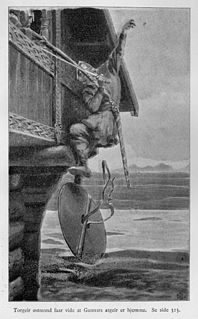 W
WAn atgeir, sometimes called a "mail-piercer" or "hewing-spear", was a type of polearm in use in Viking Age Scandinavia and Norse colonies in the British Isles and Iceland. The word is related to the old norse geirr, meaning spear. It is usually translated in English as "halberd", but most likely closer resembled a bill or glaive during the Viking age. Another view is that the term had no association with a specific weapon until it is used as an anachronism in saga literature to lend weight to accounts of special weapons. Later the word was used for typical European halberds, and even later multipurpose staves with spearheads were called atgeirsstafir.
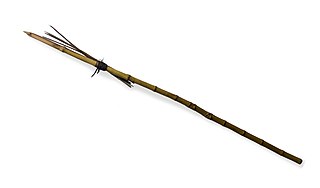 W
WBambu Runcing or Prìng Lancìp is a traditional spear made of a sharpened bamboo.
 W
WA bear spear was a medieval type of spear used in hunting for bears and other large animals. The sharpened head of a bear spear was enlarged and usually took the form of a bay leaf. Right under the head there was a short crosspiece that helped fix the spear in the body of an animal and keep it at a distance from the hunter.
 W
WA bident is a two-pronged implement resembling a pitchfork. In classical mythology, the bident is a weapon associated with Hades (Pluto), the ruler of the underworld.
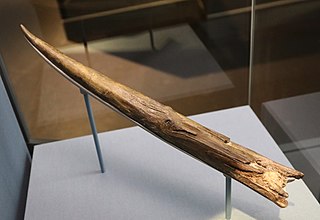 W
WThe Clacton Spear, or Clacton Spear Point, is the tip of a wooden spear discovered in Clacton-on-Sea in 1911. It is 400,000 years old and the oldest known worked wooden implement.
 W
WThe dagger-axe is a type of pole weapon that was in use from the Erlitou culture until the Han dynasty in China. It consists of a dagger-shaped blade, mounted by its tang to a perpendicular wooden shaft. The earliest dagger-axe blades were made of stone. Later versions used bronze. Jade versions were also made for ceremonial use. There is a variant type with a divided two-part head, consisting of the usual straight blade and a scythe-like blade.
 W
WDangpa, or dang pa, is the Korean name for a Ranseur first described in the Muyejebo, a Korean martial arts manual of the Joseon Dynasty.
 W
WThe gichang is a Korean weapon which is first described in the Muyesinbo, a Korean martial arts manual published in 1759. It later also found its way into the Muyedobotongji (1791).
 W
WHōzōin-ryū (宝蔵院流) is a traditional school (koryū) of Japanese martial arts that specializes in the art of spearmanship (sōjutsu). Hōzōin-ryū was founded by Hōzōin Kakuzenbō In'ei in c. 1560. In'ei was a Buddhist monk of Kōfuku-ji Temple in Nara, Japan. He adored martial arts and trained in the art of swordsmanship. At the same time, he was coached and mentored by Daizendayū Moritada (大膳太夫盛忠), a master of the spear. Under this master's guidance, In'ei honed his spearmanship.
 W
WThe Jangchang, literally long spear, is a Korean weapon first described in the 16th century martial arts manual, Muyejebo. The weapon was preferably made from the wood of the yew tree, but other types of wood could be used as well, such as oak and chestnut.
 W
WThe ji was a Chinese polearm, often translated into English as spear or halberd, though they are fundamentally different weapons. They were used in one form or another for over 3000 years, from at least as early as the Zhou dynasty, until the end of the Qing dynasty. They are still used for training purposes in many Chinese martial arts.
 W
WThe jukjangchang, literally bamboo long spear, is a Korean weapon.
 W
WThe langxian was a branched, multi-tipped spear with blades attached to the branches. The blades could be dipped in poison. The langxian was a weapon well suited for defense, as it would be difficult for an opponent to assault the wielder without risking contact with the blades.
 W
WA leister is a type of spear used for spearfishing.
 W
WThe spear or lance, together with the bow, the sword, the seax and the shield, was the main equipment of the Germanic warriors during the Migration Period and the Early Middle Ages.
 W
WThe ox tongue spear was a type of broad-headed double-edged spear that was used in Europe during the 15th and 16th centuries. Some designs had protrusions from the middle or base of the blades, making the head similar in profile to a partisan. Primarily, it was large and heavy, used by infantry in skirmishing.
 W
WA pike is a pole weapon, a very long thrusting spear formerly used extensively by infantry. Pikes were used regularly in European warfare from the Late Middle Ages and most of the Early Modern Period, and were wielded by foot soldiers deployed in close quarters, until it was largely replaced by bayonet equipped muskets. The pike found extensive use with Landsknecht armies and Swiss mercenaries, who employed it as their main weapon and used it in pike square formations. A similar weapon, the sarissa, was also used by Alexander the Great's Macedonian phalanx infantry to great effect. Generally, a spear becomes a pike when it is too long to be wielded with one hand in combat.
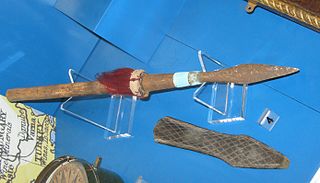 W
WQiang is the Chinese term for spear. Due to its relative ease of manufacture, the spear in many variations was ubiquitous on the pre-modern Chinese battlefield. It is known as one of the four major weapons, along with the gun (staff), dao (sabre), and the jian, called in this group "The King of Weapons".
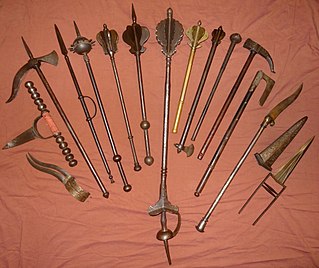 W
WThe saintie is an Indo-Persian parrying spear. It is a staff weapon that can be used both for offensive and defensive purposes. They have been produced since the 16th century and were used up to the 19th century. The use of saintie is extremely scarce today.
 W
WThe Schöningen spears are a set of ten wooden weapons from the Palaeolithic Age that were excavated between 1994 and 1999 from the 'Spear Horizon' in the open-cast lignite mine in Schöningen, Helmstedt district, Germany. They were found together with animal bones and stone and bone tools. The excavations took place under the management of Hartmut Thieme of the Lower Saxony State Service for Cultural Heritage (NLD).
 W
WSibat is the Filipino word for spear, used as a weapon or tool by natives of the Philippines. The term is used in Tagalog and Kinaray-a. It also called bangkaw, sumbling or palupad in the islands of Visayas and Mindanao; and budjak among Muslim Filipinos in western Mindanao and the Sulu Archipelago.
 W
WSōjutsu (槍術), meaning "art of the spear", is the Japanese martial art of fighting with a Japanese spear .
 W
WThe Spear of Fuchai is the spear of King Fuchai of Wu, the archrival of King Goujian of Yue. It was unearthed in Jiangling, Hubei in November 1983. The script on it is bird-worm seal script, a variant of seal script that was commonly used in the southern states such as Wu and Yue. The inscription mirrors the text of King Goujian's Sword, except changing the name of the owner and type of weapon. In this case, the text reads, "吴王夫差自作用矛" or "King Fuchai of Wu made for his personal use, this spear."
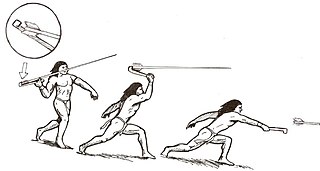 W
WA spear-thrower, spear-throwing lever or atlatl is a tool that uses leverage to achieve greater velocity in dart or javelin-throwing, and includes a bearing surface which allows the user to store energy during the throw.
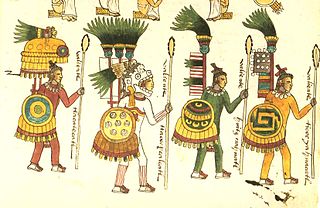 W
WThe tepoztopilli [tepostoːˈpiːlːi] was a common front-line weapon of the Aztec military. The tepoztopilli was a pole-arm, and to judge from depictions in various Aztec codices it was roughly the height of a man, although historian John Pohl indicates that the weapon used between the 12th and 14th century was made in sizes from 3 feet to 7 feet in length. The wedge-shaped wooden head, about twice the length of the users' palm or shorter, was edged with razor-sharp obsidian blades which were deeply set in grooves carved into the head. They were cemented in place with bitumen or plant resin as an adhesive. This made the tepoztopilli vaguely similar to the macuahuitl or "macana", however it had a much smaller cutting edge and a longer handle. The greater length gave the weapon a superior reach, allowing the user to stand behind a line of more experienced warriors and then "shove or jab the weapon" into an adversary.
 W
WA trident is a three-pronged spear. It is used for spear fishing and historically as a polearm.
 W
WThe trident of Poseidon and his Roman equivalent, Neptune, has been their traditional divine attribute featured in many ancient depictions. Poseidon's trident was crafted by the Cyclopes.
 W
WTrishula or trishul is a trident, a divine symbol, commonly used as one of the principal symbols in Sanatana Dharma. In India and Thailand, the term also often refers to a short-handled weapon which may be mounted on a daṇḍa. Unlike the Okinawan sai, the trishula is often bladed. In Indonesian, trisula usually refers specifically to a long-handled trident while the diminutive version is more commonly known as a cabang or tekpi.